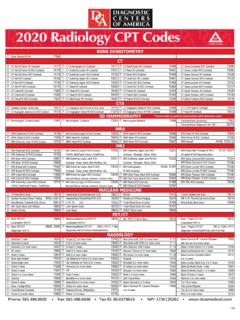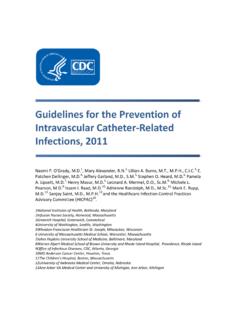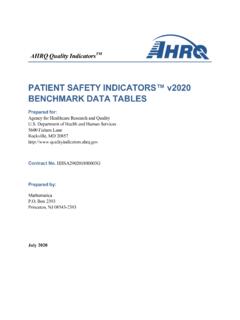Transcription of Guideline for Prevention of Infections in Neonatal ...
1 Accessible version: September 2020 Page 1 of 29 Recommendations for Prevention and control of Infections in Neonatal Intensive Care Unit Patients: Staphylococcus aureus Centers for disease control and Prevention National center for Emerging and Zoonotic Infectious Diseases Division of Healthcare Quality Promotion Date: September 2020 Aaron M. Milstone, MD, MHSa, Alexis Elward, MDb, Michael T. Brady, MDc, Kendra Cox, MAd, Loretta L. Fauerbach, MS, CICe, Judith A. Guzman-Cottrill, DOf, Jamesa Hogges, MPHg , W. Charles Huskins, MD, MSch , Kathleen L. Irwin, MD, MPHi, Martha Iwamoto, MD, MPHj, Gretchen Kuntz, MSW, MSLISk, Brian Leas, MA, MSl, Amanda D.
2 Overholt, MPHg, Kristin Tansil Roberts, MSWd, Srila Sen, MAm, Nalini Singh, MD, MPHn, Erin Stone, MAo, Craig A. Umscheid, MD, MSCEp, and Kristina Bryant, MDq, and the Healthcare Infection control Practices Advisory Committeeq aJohns Hopkins University School of Medicine, Baltimore, MD; bWashington University School of Medicine, St. Louis, MO; cNationwide Children s Hospital, Columbus, OH; dEagle Global Scientific, LLC, Atlanta, GA; eFauerbach & Associates, LLC, Gainesville, FL; fOregon Health and Science University, Portland, OR; gformerly Northrop Grumman Corporation, Atlanta, GA; hMayo Clinic, Rochester, MN; iformerly Division of Healthcare Quality Promotion, National center for Emerging and Zoonotic Infectious Diseases, Centers for disease control and Prevention , Atlanta, GA (now with the Agency for Healthcare Quality Research, Rockville, MD).
3 Jformerly Division of Healthcare Quality Promotion, National center for Emerging and Zoonotic Infectious Diseases, Centers for disease control and Prevention , Atlanta, GA (now with the New York City Department of Health and Mental Hygiene, New York, NY); kformerly center for Evidence-based Practice, University of Pennsylvania Health System, Philadelphia, PA (now with the University of florida -Jacksonville, Jacksonville, FL); lCenter for Evidence-based Practice, University of Pennsylvania Health System, Philadelphia, PA; mformerly Eagle Global Scientific, LLC, Atlanta, GA (now with The Bizzell Group, Lanham, MD); nformerly Division of Healthcare Quality Promotion, National center for Emerging and Zoonotic Infectious Diseases, Centers for disease control and Prevention , Atlanta, GA (now with Department of Pediatrics, Department of Global Health and Epidemiology, George Washington University, Washington DC);oDivision of Healthcare Quality Promotion, National center for Emerging and Zoonotic Infectious Diseases, Centers for disease control and Prevention , Atlanta, GA.
4 Pformerly center for Evidence-based Practice, University of Pennsylvania Health System, Philadelphia, PA (now with the University of Chicago Medicine, Chicago IL); qUniversity of Louisville, Louisville, KY. Authors are listed alphabetically, with the exception of the first two authors and the last author, based on workgroup role. Recommendations for Prevention and control of Infections in Neonatal Intensive Care Unit Patients: Staphylococcus aureus September 2020 Page 2 of 29 Table of Contents 1. Executive Summary ..3 2. Summary of Recommendations ..4 3. Introduction .. 11 4. Methods .. 12 Development of Key Questions.
5 12 Literature Search .. 12 Study Selection .. 13 Data Extraction and Synthesis .. 13 Grading of the Evidence .. 14 Formulating Recommendations .. 14 Reviewing and Finalizing the Guideline .. 14 Updating the Guideline .. 14 5. Evidence Summaries .. 14 Interventions to prevent transmission of S. aureus in NICUs .. 14 Risk Factors and Risk Indicators for S. aureus in NICU Patients .. 21 6. References .. 23 7. Contributors .. 27 8. Acronyms and 29 Recommendations for Prevention and control of Infections in Neonatal Intensive Care Unit Patients: Staphylococcus aureus September 2020 Page 3 of 29 1.
6 Executive Summary Recommendations for the Prevention and control of Staphylococcus aureus in Neonatal Intensive Care Unit Patients provides new, evidence-based recommendations specific to the Prevention and control of Staphylococcus aureus (S. aureus), including methicillin-resistant S. aureus (MRSA) and methicillin-sensitive S. aureus (MSSA), in Neonatal intensive care unit (NICU) patients. This document is one section of the full Guideline for Infection Prevention and control in Neonatal Intensive Care Unit Patients. This Guideline will be published in a segmental manner as sections are completed. This section does not provide a comprehensive set of infection control recommendations for the Prevention of S.
7 Aureus in NICU patients, but instead supplements other CDC guidelines. The term S. aureus includes both MSSA and MRSA. Core infection Prevention and control recommendations for the Prevention of S. aureus that apply across all healthcare settings are summarized in the Healthcare Infection control Practices Advisory Committee (HICPAC) Core Practices document,1 and the original recommendations can be found in the respective Centers for disease control and Prevention (CDC) and HICPAC Guidelines. This document is intended for use by infection Prevention staff, healthcare epidemiologists, healthcare administrators, nurses, neonatologists, other healthcare providers, and persons responsible for developing, implementing, and evaluating infection Prevention and control programs for NICUs.
8 The Guideline can also be used as a resource for societies or organizations that wish to develop more detailed implementation guidance for the Prevention of infection in NICU patients. The recommendations were based on a systematic review of the best available literature through August 2019. Subject matter experts supplemented the literature search results by recommending relevant references published since August 2019. In order to provide explicit links between the evidence and recommendations, an adapted GRADE approach was used to evaluate the strength and direction of the evidence and formulate recommendations.
9 The Methods section of this Guideline provides additional detail on the development of this document. Where evidence was insufficient to formulate evidence-based recommendations, interim guidance is available to inform the delivery of healthcare in NICUs: SHEA Neonatal intensive care unit (NICU) white paper series: Practical approaches to Staphylococcus aureus disease Prevention ( ). The evidence review for S. aureus was guided by these Key Questions: 1. What are effective strategies for preventing S. aureus transmission from colonized or infected NICU patients to other patients, and do these strategies differ between MRSA and MSSA or in the setting of an outbreak?
10 2. If screening is conducted, which anatomic sampling sites and laboratory assays most effectively identify S. aureus colonization in NICU patients? 3. What are the risk factors and risk indicators for S. aureus infection in NICU patients, and do these factors differ between MRSA and MSSA or in the setting of an outbreak? 4. What are the risk factors and risk indicators for S. aureus colonization in NICU patients, and do these factors differ between MRSA and MSSA or in the setting of an outbreak? Readers wishing to examine the primary evidence underlying the recommendations are referred to the Evidence Review in the body of this document and to the Tables in the Appendix.












